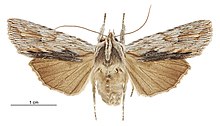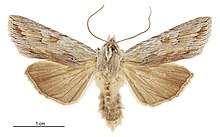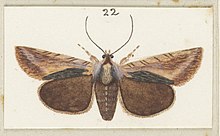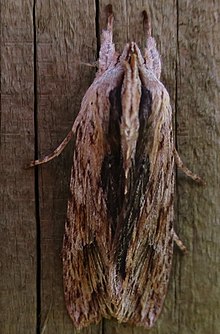| Physetica prionistis | |
|---|---|

| |
| Female | |

| |
| Male | |
| Scientific classification | |
| Domain: | Eukaryota |
| Kingdom: | Animalia |
| Phylum: | Arthropoda |
| Class: | Insecta |
| Order: | Lepidoptera |
| Superfamily: | Noctuoidea |
| Family: | Noctuidae |
| Genus: | Physetica |
| Species: | P. prionistis |
| Binomial name | |
| Physetica prionistis (Meyrick, 1887) | |
| Synonyms | |
| |
Physetica prionistis is a moth of the family Noctuidae. It was described by Edward Meyrick in 1887. It is endemic to New Zealand and is widespread throughout the North, South and Chatham Islands. This species can be found in open clearings of shrubland and forest at altitudes from sea level up to the alpine zone. Adults are on the wing throughout the year and are attracted to sugar traps and occasionally to light. The life history of this species is unknown as are the larval host species.
Taxonomy
This species was first described by Edward Meyrick in 1887 and named Mamestra prionistis. In 1898 George Hudson discussed this species under the name Melanchra prionistis. In 1928 Hudson again discussed the species under the same name. In 1988 J. S. Dugdale placed this species in the genus Graphania. In 2017 Robert Hoare undertook a review of New Zealand Noctuinae and placed this species in the genus Physetica. The lectotype specimen was collected by Richard William Fereday in Rakaia and held at the Natural History Museum, London.
Description


Meyrick described the species as follows:
Male. — 45 mm. Head, palpi, thorax, and legs grey-whitish ; crown with two brown lines meeting in front ; palpi with second joint externally brown ; thorax with large anterior crest, two brown dorsal lines meeting in front, diverging and very indistinct posteriorly. Antennae grey, filiform, moderately ciliated. Abdomen grey, sides and anal tuft paler, and ochreous-tinged. Forewings moderately dilated, costa straight, apex obtuse, hind-margin crenulate, obliquely rounded ; pale ochreous-grey, densely and suffusedly irrorated with white, tending to form longitudinal streaks ; inner margin suffused with brownish ; lines hardly traceable, strongly dentate ; reniform narrow, white, anteriorly suffused, posteriorly edged with an interrupted blackish line ; subterminal indicated by a posterior brownish dentate margin, diverted to hindmargin below apex : cilia ochreous-grey, mixed with white. Hindwings rather dark grey ; cilia whitish, with a grey line.
The adult male of this species has a wingspan of between 37 and 45 mm and the female of between 39 and 43 mm. This species is distinctive as it has a white central stripe down its thorax and the darker stripe of colour along the back part of the forewing.
Distribution
This species is endemic to New Zealand and is widespread throughout the North, South and Chatham Islands. This species is regarded as being rare in most locations however it has been found to be common at Mount Te Aroha.
Habitat
This species is found in open clearings of shrubland and forest at altitudes from sea level up to the alpine zone (at least 1850 m).
Behaviour
This species is on the wing throughout the year and are attracted to sugar traps and occasionally to light. This species can sometimes be found during the day resting on trees, where it is camouflaged by its colouring.
Life history and host species
The life history of this species is unknown as are the larval host species. The larvae of this species have yet to be found.
References
- ^ Edward Meyrick (1887). "Monograph of New Zealand Noctuina". Transactions and Proceedings of the New Zealand Institute. 19: 27. ISSN 1176-6158. Wikidata Q104048034.
- ^ George Vernon Hudson (1898), New Zealand moths and butterflies (Macro-lepidoptera), Illustrator: George Hudson, London, p. 27, doi:10.5962/BHL.TITLE.7912, OCLC 980865393, Wikidata Q19073637
{{citation}}: CS1 maint: location missing publisher (link) - ^ Hudson, G. V. (1928), The butterflies and moths of New Zealand, Illustrator: George Hudson, Wellington: Ferguson and Osborn Limited, p. 75, LCCN 88133764, OCLC 25449322, Wikidata Q58593286
- Dugdale , J. S. (23 September 1988). "Lepidoptera - annotated catalogue, and keys to family-group taxa". Fauna of New Zealand. 14. Department of Scientific and Industrial Research: 205. doi:10.7931/J2/FNZ.14. ISSN 0111-5383. Wikidata Q45083134.
- ^ Robert Hoare (23 June 2017). "Noctuinae (Insecta: Lepidoptera: Noctuidae) part 1: Austramathes, Cosmodes, Proteuxoa, Physetica" (PDF). Fauna of New Zealand. 73. Illustrator: Birgit E. Rhode. Manaaki Whenua – Landcare Research: 52–54. doi:10.7931/J2/FNZ.73. ISSN 0111-5383. OCLC 1002177011. Wikidata Q44893580.
- ^ Robert Hoare (2020), The Moths of Mt Te Aroha (PDF), pp. 1–11, Wikidata Q113345596, archived from the original (PDF) on 7 March 2022
| Taxon identifiers | |
|---|---|
| Physetica prionistis | |
| Graphania prionistis | |
This Hadeninae-related article is a stub. You can help Misplaced Pages by expanding it. |